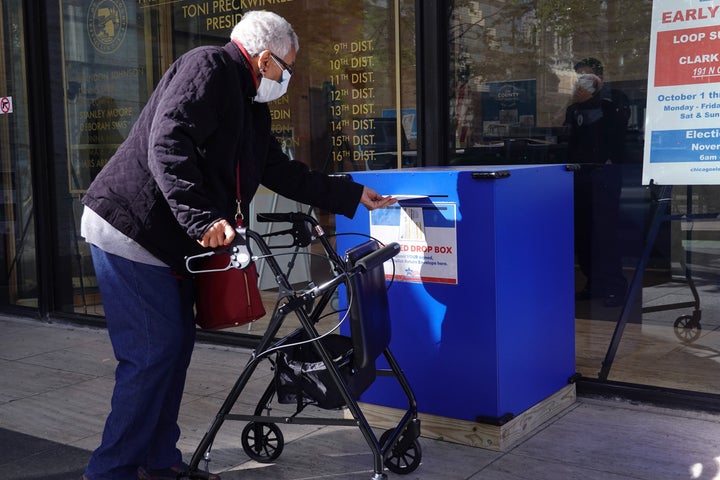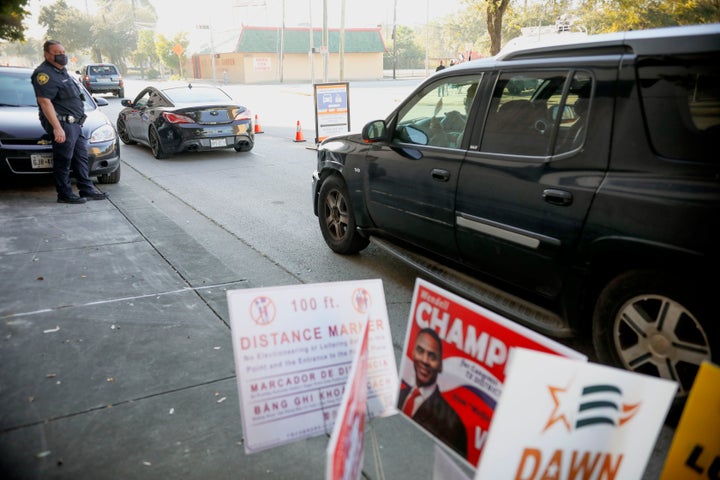
Americans with disabilities were more satisfied than ever with their voting experiences during the 2020 elections as a raft of changes meant to make elections safer during the COVID-19 pandemic made casting ballots easier for a population that has struggled for decades to easily access polling sites.
But a wave of voting restrictions that Republicans have proposed or already passed across the country is threatening to not just halt that progress but significantly reverse it.
Some of these proposals specifically targeted people with disabilities. Texas’ SB 7, a sweeping package of voting restrictions that the state Senate passed in April, initially would have required people to prove that they have a disability to vote by mail. A similar bill that passed the Texas House in early May didn’t go quite as far but, like the Senate legislation, originally sought to place new restrictions on people who assist voters who have disabilities before certain provisions were amended or removed from the bill at the last moment.
But virtually all of the new voting restrictions, including the laws Georgia and Florida Republicans have enacted, will likely reduce people with disabilities’ access to the ballot, advocates say, because any voting restriction tends to have a disproportionate effect on voters with disabilities.
“A lot of the more restrictive laws that we see proposed don’t directly mention people with disabilities,” said Michelle Bishop, who works on voting and election access policy at the National Disability Rights Network in Washington. “But whether or not people with disabilities are being targeted, they are living with the consequences.”
About 13% of the U.S. population, or roughly 41 million people, identify as having a disability, according to the U.S. Census Bureau’s American Community Survey. But the number of Americans with a disability is likely far higher because many elderly Americans with visual and physical issues, and others with chronic degenerative diseases, such as multiple sclerosis or rheumatoid arthritis, often don’t consider themselves as having a disability. The U.S. Centers for Disease Control and Prevention estimates that 61 million adults, or about 25% of the adult population, live with some sort of disability.
Millions of voters, as a result, likely don’t realize that they are legally entitled to accommodations and assistance at polling sites and in elections, or that there are existing carve-outs in many election laws that allow people with disabilities to more easily vote by mail or use other options. Longer voting lines and tighter restrictions on alternative voting options are likely to make casting a ballot harder for them or even deter many from voting at all.
Voting has always been harder for people with disabilities. In 2012, nearly one-third of voters with disabilities reported difficulties voting, according to a survey conducted by researchers at Rutgers and Syracuse universities. Turnout for the 2012 election was nearly 6% lower among voters with disabilities than among the general public, the equivalent of 3 million missing votes.
“The Americans With Disabilities Act is 30 years old, and the majority of polling places in the United States are still not fully accessible, even for traditional in-person voting,” Bishop said. “We’ve made a lot of progress, but we just haven’t necessarily solved this issue yet.”
During the pandemic, in the face of fears that voting would be unsafe and carry health risks, state and local election officials instituted a wide array of changes to make voting more accessible, including the broader adoption of no-excuse mail-in voting, curbside voting, ballot drop boxes, early voting and provisions that allow time for voters to fix errors made on absentee ballots. Many states also automatically sent mail-in ballots to registered voters, removing a step that required voters to fill out forms requesting such ballots.
“The best thing we can do in the world of elections is to offer as many options as possible for all voters. And then every method of voting needs to be fully accessible to people with disabilities as well.”
- Michelle Bishop, National Disability Rights Network
Just 18% of voters with disabilities reported difficulties last year, a steep drop from just eight years ago, a survey conducted by Lisa Schur and Douglas Kruse, the co-directors of Rutgers’ Program for Disability Research, found. Many of the gains came from improvements at in-person polling places, but the increased number of options certainly contributed to the progress: Three-quarters of voters with disabilities voted early or cast mail-in ballots last year, compared with roughly two-thirds of the general electorate. Among the voters with disabilities who voted by mail, nearly 16% used drop boxes. Just 5% of those who voted by mail reported any difficulties.
“There isn’t one type of disability, so it’s not one-size-fits-all in terms of accessibility for people with disabilities,” Schur said. “What we found is most helpful is for people with disabilities to have a lot of different options. The more options, the better.”
The pandemic-inspired increase in voting options was popular among the general public, polls have shown, but voters with disabilities appear to have enjoyed them even more: While half of voters with disabilities said they’d prefer to vote in person in future elections, 32% would like to keep voting absentee. By contrast, 60% of voters without disabilities would rather vote in person, and just 19% preferred mail-in ballots.
And though advocates have for decades fought for voting changes specifically meant to benefit people with disabilities, the 2020 election bolstered another argument that they have made to policymakers for years: Making it easier for all voters to cast ballots can have an especially positive effect on voters with disabilities.
“The best thing we can do in the world of elections is to offer as many options as possible for all voters,” Bishop said. “And then every method of voting needs to be fully accessible to people with disabilities as well.”
But the reverse is also true: Any change that makes it harder for voters as a whole to cast ballots will inherently have an ever larger effect on people with disabilities. Black people, Latinos and Native Americans, who bear an unequal brunt of voting restrictions, are also all disproportionately likely to have disabilities, so any new limit on voting hits disabled members of those communities doubly hard. During the 2020 elections, Black voters with disabilities had to wait twice as long in line at in-person polling places as white voters with disabilities, the Rutgers survey found.
Many states have sought to enshrine pandemic-driven changes into law for future elections, and lawmakers in Massachusetts, Montana and Virginia have all passed new laws specifically meant to improve accessibility for voters with disabilities. But Republican state legislatures across the country have taken aim at the most popular and beneficial pandemic-inspired reforms from 2020, a push fueled by the lie that voting by mail, curbside voting, drop boxes and other changes inspired widespread fraud that cost former President Donald Trump the election. (No such fraud occurred.)
Republicans in the Texas Senate passed a bill in April that would ban drive-thru voting and bar local officials from mailing out request forms for absentee ballots unless they’re specifically requested each election. Texas is already one of the most restrictive states for voting; in order to acquire an absentee ballot, voters must be older than 65 or have a disability. The legislation originally would have changed the law to require that people requesting an absentee ballot provide written proof of their disability status, a reform GOP lawmakers argued is necessary because “folks claiming disability who do not in fact have a disability” are the biggest source of “mail ballot fraud,” as one Republican state senator told Spectrum News.
Though there is one criminal case involving disability-related mail ballot fraud proceeding in Texas, there is “no hard evidence” that it is a widespread practice, said Jeffrey Miller, a policy specialist at Disability Rights Texas, which helps monitor an election-related hotline for voters with disabilities.

The bill also would have initially required anyone who helps a voter fill out a ballot to attest to their relationship and why assistance was necessary on a separate form, out of apparent fears that such assistance is routinely used to “exploit” people with disabilities, another GOP lawmaker argued to Spectrum. The House passed a slightly different voting restriction bill that would not require proof of disability to obtain an absentee ballot but originally contained similar provisions on assistance. Failing to fill out the required assistance form would have carried criminal penalties, which, along with provisions that allow for increased numbers of poll watchers, could create “a chilling effect” for both voters with disabilities and the people who assist them, Miller said.
Texas Republicans were, in effect, trying to fix an imaginary problem instead of taking aim at the issues voters with disabilities face at the polls each election. Most of the specific disability-related provisions were stripped from both bills before they passed, according to the Texas Tribune, although disability advocates like Miller worry they could resurface during a conference committee to reconcile the two pieces of legislation. But even without those provisions, other restrictions in the bills ― like its ban on drive-thru voting, a change Republicans are seeking largely because it was utilized last year in heavily Democratic Harris County, where Houston is located ― would also negatively affect voters with disabilities.
“There are definitely going to be new barriers for voters with disabilities,” Miller said. “Both of these bills have lots of problems on their own and would definitely impact voters with disabilities just because they reduce options for people.”
Other new laws, like those in Florida and Georgia, will have a similar effect, as GOP lawmakers seek to ban or limit curbside voting, roll back vote-by-mail programs, institute even tougher photo identification requirements and enact other restrictions, such as limits on third-party ballot submission.
It’s too early, experts say, to predict how much of a burden these changes could have on voters with disabilities, especially compared with last year’s election. But curbside voting, drop boxes and mail-in ballots all provide options to in-person voting that improve access for people with mobility-related disabilities, while automatic voter registration or permanent vote-by-mail lists, like the one some Arizona Republicans wanted to eliminate, reduce burdens on voters with cognitive, visual, mental and physical disabilities by requiring them to go through the process of registering and obtaining ballots only once.
People with disabilities are also less likely to drive, and thus less likely to have a driver’s license or other form of photo identification. Enhanced voter ID laws disproportionately affect their ability to vote, and place new barriers in front of them, especially because government facilities where IDs can be obtained are often difficult to access for many people with disabilities. Aggressive signature matching requirements on absentee ballots, meanwhile, are often more difficult to meet for people with disabilities, a problem exacerbated by many GOP lawmakers’ opposition to “ballot curing” processes that allow voters to fix problems that arise instead of having their ballots tossed out.
“Something that might just be a nuisance for someone without a disability can really be a burden for someone with a disability,” Schur said.
The 2020 election was far from perfect, and no single change made for it will, by itself, make elections fully equitable. People with disabilities were still more likely to report difficulties voting ― the number who had difficulties voting by mail was still more than twice as high as among those without disabilities, according to the Rutgers survey. Though it makes it easier for many voters to avoid problems that typically arise at polling places, absentee voting can be more difficult for people with visual and cognitive disabilities, so programs like vote-by-mail, as well as newer initiatives, like online registration and voting, still need improvements to make them fully accessible.
Because most voters with disabilities would still like to vote in person, states and localities need to continue making polling places and voting machines more accessible. And election processes overall need to be designed and implemented with people with disabilities in mind, not merely “retrofitted” in a last-minute effort to accommodate them, Bishop said. And many of the technologies and practices meant to help people with disabilities ― like machines with larger text that are easier to read and use for people with visual impairments ― would also have major benefits for people without disabilities and people who do not identify as disabled, she said.
For all its flaws, though, the bevy of voting options may have provided an even bigger boost for voters with disabilities than it did for voters overall. But instead of using last year’s election as a springboard for further progress, many Republican lawmakers across the country are going backward again.
“We’ve spent the last 20 years fighting for more accessible voting systems and more accessible polling places,” Bishop said. “But I don’t know what good that does to someone who’s in line for several hours in the Georgia heat and no one’s allowed to give them water.”
